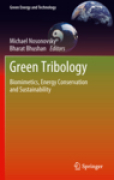
Green tribology: biomimetics, energy conservation and sustainability
Nosonovsky, Michael
Bhushan, Bharat
Tribology is the study of friction, wear and lubrication. Recently, the concept of “green tribology” as “the science and technology of the tribological aspects of ecological balance and of environmental and biological impacts” was introduced. The field of green tribology includes tribological technology that mimics living nature (biomimetic surfaces) and thus is expected to be environmentally friendly, the control of friction and wear that is of importance for energy conservation and conversion, environmental aspects of lubrication and surface modification techniques, and tribological aspects of green applications such as wind-power turbines or solar panels. This book is the first comprehensive volume on green tribology. The chapters are prepared by leading experts in their fields and cover such topics as biomimetics, environmentally friendly lubrication, tribology of wind turbines and renewable sources of energy, and ecological impact of new technologies of surface treatment. Presents green tribology. Important for lubrication engineering. Gives information on biomimetic surfaces, self-cleaning surfaces, surface-healing and friction in living nature. Important chapter on the Lotus effect and surface microstructuring. Practical information on antifouling surfaces and tribology ofwind power turbines. INDICE: Introduction. Part One: Biomimetics. Biomimetic surfaces: an overview. Lotus effect for non-adhesive surfaces. Friction in living nature. Biomimetic microstructured surfaces for dry friction. Self-lubrication in nature andengineering. Gecko-effect. Surface-healing composite materials. Self-replenishing lubrication. Part Two: Control of Friction and Wear. Surface texturing for friction and wear control. Solid lubrication. Self-organization during friction. Part Three: Environmental Aspects of Lubrication and Surface Modification. Environmentally-friendly lubricants: biodegradable and non-toxic. Environmental aspects of the Lotus effect and surface microstructuring. Self-cleaning polymeric surfaces. Self-cleaning metallic surfaces. Antifouling surfaces: environmental aspects. Part Four: Green Applications. Tribology of wind power turbines. Self-cleaning solar panel coatings. Surface modification and new ways of energy transition. Closure.
- ISBN: 978-3-642-23680-8
- Editorial: Springer Berlin Heidelberg
- Encuadernacion: Cartoné
- Páginas: 931
- Fecha Publicación: 30/11/2011
- Nº Volúmenes: 1
- Idioma: Inglés
